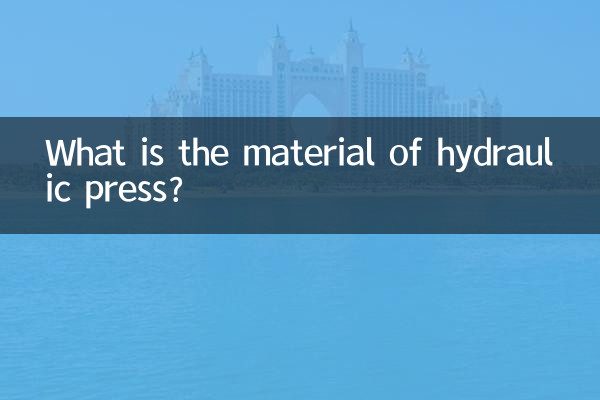What is the material of hydraulic press?
Hydraulic press is a kind of mechanical equipment widely used in industrial fields. Its material selection is directly related to the performance, durability and safety of the equipment. This article will combine the hot topics and hot content on the Internet in the past 10 days, analyze the material composition of the hydraulic press in detail, and present relevant information in the form of structured data.
1. Main material composition of hydraulic press

The material selection of a hydraulic press needs to take into account characteristics such as strength, wear resistance, and corrosion resistance. The following is the material classification of its main components:
| Part name | Commonly used materials | Feature description |
|---|---|---|
| fuselage frame | High strength cast iron, welded steel plate | Strong pressure resistance and high stability |
| Hydraulic cylinder | Alloy steel (such as 42CrMo) | High pressure resistance and wear resistance |
| Piston rod | Chrome plated alloy steel | Anti-rust and wear-resistant |
| Seals | Polyurethane, nitrile rubber | Good elasticity and good oil resistance |
| fuel tank | carbon steel or stainless steel | Anti-corrosion, easy to clean |
2. Industry trends in material selection (hot spots in the past 10 days)
According to recent industry discussions and technical analysis, the field of hydraulic press materials shows the following trends:
1.Lightweight design: Some manufacturers have begun to try to use high-strength aluminum alloys to replace traditional steel to reduce the weight of equipment.
2.Environmentally friendly materials: The research and development of new bio-based sealing materials has become a hot topic, and the number of related patents has increased by 15% year-on-year.
3.Nano coating technology: The surface treatment of the piston rod adopts a new nano-coating, which increases the wear-resistant life by more than 30%.
3. Material differences in different application scenarios
| Application areas | Material characteristics | Typical representative |
|---|---|---|
| metal processing | ultra high strength alloy | The forging press uses 42CrMo4 steel |
| plastic molding | Anti-corrosion coating | Electroplated nickel alloy frame |
| car repair | Portable design | Aluminum alloy hydraulic jack |
| Aerospace | Titanium alloy components | Special hydraulic actuator |
4. Comparative analysis of material properties
The following is a comparison of the performance parameters of mainstream hydraulic press materials:
| Material type | Tensile strength (MPa) | Hardness(HB) | Temperature resistance range (℃) |
|---|---|---|---|
| QT500 cast iron | 500-700 | 170-240 | -20~300 |
| 42CrMo alloy steel | 1080-1300 | 280-320 | -40~450 |
| 6061 aluminum alloy | 290-310 | 95 | -100~150 |
5. Key considerations in material selection
1.work pressure: High-pressure systems (>30MPa) must use high-strength alloy steel.
2.Media compatibility: The type of hydraulic oil determines the selection of sealing materials. For example, phosphate ester oil requires fluororubber.
3.environmental conditions: Marine environment requires stainless steel or special coating.
4.Cost effective: Mass production favors welded structures rather than castings.
6. Breakthroughs in the latest material technology
According to recent academic journals and industry reports, new developments worth noting include:
- Graphene reinforced composite materials used in ultra-high pressure cylinders (laboratory stage)
- Application of self-healing coating technology in hydraulic seals (commercial products are already available)
- 3D printing technology to manufacture complex hydraulic components (small batch applications)
Conclusion:Material selection for hydraulic presses is a balancing art that requires comprehensive consideration of mechanical properties, environmental adaptability and economy. With the development of material science, hydraulic machines will develop in the direction of being lighter, stronger, and more durable in the future.

check the details

check the details